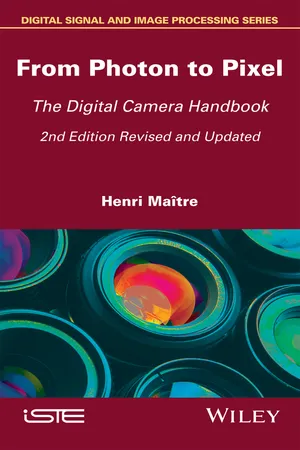1.1. Toward a society of the image
To say that, over the last 30 years, a real revolution has taken the world of photography by storm and deeply modified the multiple technical, economic, industrial and societal aspects in which it develops would be an understatement.
From a technical perspective, the replacement of analog silver film by solid digital sensors, tentatively began 40 years ago, emulating a transition from analog to digital that is found in many other fields (the telephone, television, printing, etc.), could have certainly been no more than a significant progress, but in the end a natural one and of little impact for the user (is the user really conscious of the transition to digital terrestrial television or of the phototypesetting of newspapers?). However, it has profoundly modified the concept of photography itself, bringing forward several types of original devices; first, the point-and-shoot that fits in a pocket and that can be forgotten, then the mobile phone or the tablet, which the photographic industry would gladly repudiate as illegitimate and somewhat degenerate children if they did not hold the promise of an inexhaustible market.
The consequences of this technical mutation have proved to be devastating for the established economy of photography. Major players (Kodak, Agfa, Fuji, Ilford, Minolta, etc.) which seemed to be ruling empires were forced to fall back on uncertain niches, to regroup and sometimes disappear. Newcomers have settled down, whose photographic culture was often thin (Sony and Samsung), sometimes non-existent (Nokia, Apple, etc.). Other players are building kingdoms from scratch around online image services or their social networks, but these are people with Internet, computing and telecoms backgrounds and not photographic ones. Whereas the chemical industries that produced films and derived products have naturally strongly suffered, processing laboratories, if they had not disappeared entirely, had to be totally reconverted and distribution has begun a profound transformation whether it relates to materials or to services.
The reconfigurations of the industrial fabric, far from being completed, continue today, involving more and more closely players who ignored each other, some coming from imaging, but many who prospered without being related to photography professions: on-board electronics experts, creators of integrated circuits, software developers, network and mobile phone key players have been transformed into designers of camera bodies and objectives.
Society’s activities are themselves deeply affected by these reconfigurations. Have they accompanied the industrial mutation or are they one of the causes? It is not up to us to say. But the societal mutations of photography are equally significant and irreversible. They reveal themselves in several ways, but first of all it is the generalization of the use of photography that is striking. Generalization within the family: photography is no longer the prerogative of the pater familias as at the beginning of the previous century, of adults and of old adolescents as at the end of the century. It is now a personal attribute that every one uses, children as well as grandparents. Society as a whole is also exposed to it and there is no niche regardless of the level of wealth or education, that escapes from it, no population, regardless of its location, city or rural, that does not participate in it. And its distribution is remarkably diffuse over the globe, no country is excluded, at least in the component of its population exposed to modern life.
At this point, we need to recall, by rereading the famous analysis that Bourdieu and his collaborators made fifty years ago, the achievements made for half a century [BOU 65]. While there is no evidence that photography is no longer an “average art” as they deplored at the time, it is obvious that the family, the cultural and the socio-professional categories that then allowed the identification of typical behaviors with regard to photography are now completely blurred. Attitudes are surprisingly similar between a class of Parisian students on a field trip, a bus of older Japanese tourists in Capri, or the crowd gathered for the return of a rock-star at Wembley Stadium. Photography is ubiquitous and permanent, it is spontaneous, individual and collective, frantic and viral, intimate and shared and very few can escape from it.
This universal infatuation with photography profoundly affects its usages. Certainly whole swathes of the photographic “culture” remain almost unchanged (art photography, event photography (family or public), professional newspapers, catalogues and advertising photography, scientific photography, etc.), and the reader would find word for word, for these areas, the relevance of Bourdieu’s analysis. But old facets tend to rise or become distorted, new facets emerge: leisure or travel photography now free from “old fashion” conformity stereotypes (at the expense of a “young” conformity?), everyday-life photography, detailed, anecdotal, sensational, observational, unusual photography, self portraiture alone or with others, microcosm, microcommunity photography and its culmination into the narcissic selfie. These new forms combine an often simplified manner of photography and modern means of instantaneous, remote and mass communication; it relies on a formidable technique, both hidden and exhibited, following the rules of the best marketing. MMS1 and the Internet are the natural extensions of the photographic image; social networks work as their magnifier unless they are the objective. It remains undecided nowadays whether YouTube, Facebook, Twitter, Instagram, Tumblr, Picasa and Flickr must be included or not in “photography products”.
The figures say everything about this unprecedented evolution, but they do not explain anything2. It would be naive to imagine that it owes everything to the advent of digital image and of its natural creation tool, the still camera.
It is however doubtful that such a development never would have occurred to such an...
